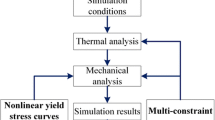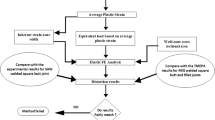Abstract
During welding, deformation is produced as an unavoidable consequence. The inherent deformation method, in which the inherent deformation is introduced into the elastic finite element method (FEM) as the initial strain, is one of the effective methods to predict the welding distortion of large structures. However, the values of the inherent deformations for all weld joints included in the structure must be known beforehand. Generally, the inherent deformations are influenced by various factors such as materials, welding method, welding condition, joint geometry, plate thickness, and weld length. Thus, it is meaningful to develop a simple method to obtain the inherent deformation. In this report, a simple and efficient method to estimate inherent deformation of typical weld joints is proposed. Further, using the estimated inherent deformation, the welding deformation of joint specimens and large plate structures are predicted.
Similar content being viewed by others
References
Luo Y., Murakawa H., Ishiyama M.: Study on welding deformation of plate with longitudinal curvature, Proceedings of Symposium of Welding structure, 1999, pp. 311–317 (in Japanese).
Satoh K., Terasaki T.: Effect of welding condition on welding deformation in welded structural materials, Journal of the Japan Welding Society, Vol. 45, 1976, pp. 302–308 (in Japanese).
Deng D., Serizawa H., Murakawa H.: Theoretical prediction of welding distortion in thin curved structure during assembly considering gap and misalignment, Symposium of welding structure, 2002, pp. 129–136 (in Japanese).
Deng D., Murakawa H., Ueda Y.: Theoretical prediction of welding distortion considering positioning and gap between parts, International Journal of Offshore and Polar Engineering, Vol. 14, No. 2, 2004, pp. 138–144.
Measurement of inherent deformation in typical weld joints using inverse analysis (Part 1) Inherent deformation of bead on welding, Transactions of JWRI, Vol. 33, 2004, No. 1, pp. 45–51.
ABAQUS/Standard Manual Version 6.4, Vols. 1, 2 and 3.
Author information
Authors and Affiliations
Rights and permissions
About this article
Cite this article
Liang, W., Deng, D., Sone, S. et al. Prediction of Welding Distortion by Elastic Finite Element Analysis using Inherent Deformation Estimated Through Inverse Analysis. Weld World 49, 30–39 (2005). https://doi.org/10.1007/BF03266500
Published:
Issue Date:
DOI: https://doi.org/10.1007/BF03266500




